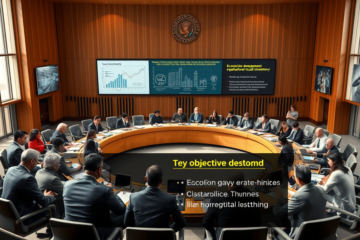Delinquency on Revolving Credit Cards Grows
Default on the card revolving credit has become a growing concern in the Brazilian economic scenario.
With rates exceeding 60%, the increase in the total loaned for this type of credit, which reached R$ 79.4 billion, highlights the financial fragility of families.
This article explores the alarming rise in defaults, both on revolving credit cards and installment cards, and analyzes how economic and behavioral factors contribute to people's financial vulnerability.
Furthermore, we will address the consequences of unsustainable credit use, exacerbated by high interest rates, and its impact on the quality of life of those in debt.
Overview of default on revolving and installment credit
Defaults on _revolving credit_ in Brazil exceeded 60%, an alarming reflection of the challenging economic conditions Brazilians face.
The amount borrowed under the _revolving credit_ reached R$ 79.4 billion, representing an increase of 30.8% compared to December 2024. This type of credit consists of a short-term loan that users can access when they are unable to pay their credit card bill in full.
With the _interest_ that can exceed 300% per year, it becomes unsustainable, exacerbating the financial situation of consumers.
In relation to _installment credit_, default increased from 11.5% to 13.2% in the same period of one year.
This modality allows consumers to pay for their purchases in several installments, generally with lower _interest_ rates compared to _revolving_.
- Default on installment cards rose from 11.5% to 13.2%
- Delinquency on _revolving credit_ increased from 55.4% to 60.5%
- Debt for those earning up to three minimum wages went from 5.4% to 6.7%
These numbers reflect the growing vulnerability of Brazilian families, who have to deal with disproportionate interest rates, compromising their disposable income and impacting the population's quality of life. as reported by VEJA.
Economic and behavioral impacts of high default rates
High credit card default rates have had significant impacts on the economy and family behavior.
The increased difficulty in paying off debts compromises consumption and consumer confidence, creating a self-reinforcing cycle that intensifies financial vulnerability.
As a result, many face limitations in obtaining credit, hampering their access to essential goods and services.
Factors that fuel the growth of defaults
High inflation and rising unemployment are crucial economic factors driving credit card defaults.
With inflation eroding purchasing power, many consumers are forced to resort to revolving credit, which has interest rates that can exceed 300% per year.
Furthermore, the unemployment rate, which remains high, contributes to families' lack of financial stability, significantly impacting their ability to repay debts. ***Limited financial education*** also plays a significant role.
Many users do not understand the risks of revolving credit, leading to a spiral of debt.
“According to economist Carlos Silva, ***'the lack of understanding about the composition of interest and the absence of financial planning result in mistaken decisions that increase default***'”, reinforcing the importance of financial knowledge to avoid the excessive use of credit.
Behaviorally, unbridled credit consumption is fueled by a search for immediate improvements in quality of life, without considering the long-term impact, as detailed in the specialized portal Atacadão Card, bringing warnings about the reckless management of personal finances.
Consequences for quality of life and disposable income
Credit card default directly affects consumers' quality of life, as the commitment of income to interest that can exceed 300% per year deteriorates the ability to meet basic needs.
With the increase in financial expenses, fixed expenses such as food, housing and savings are left in the background, leading families to situations of great social vulnerability.
As economic challenges intensify, pressure on income, particularly among groups earning up to three minimum wages, becomes more severe.
To better understand the impacts of these issues, the effects manifest themselves in several ways:
- Decreased ability to acquire quality food
- Impoverishment of housing conditions
- Impossibility of saving, worsening financial insecurity
Consumers, according to the analysis of causes and consequences discussed in relationship between card use and Brazilian debt, face difficulties in honoring their commitments.
The weight of this debt, as highlighted by economic analyses, intensifies a cycle of poverty where more and more resources are allocated solely to paying abusive interest to the detriment of other basic needs.
Therefore, to avoid extreme sacrifices, seeking planned financial solutions is essential.
Indebtedness of families with incomes up to three minimum wages
The increase in debt ratio among families earning up to three minimum wages, rising from 5,4% to 6,7%, highlights the growing pressure on the budget of these families.
This sharp growth reflects not only inflation and rising costs of living, but also the overuse of and reliance on loans such as revolving credit.
With annual interest that can exceed 300%, low-income families find themselves in a spiral of debt, making it difficult to meet basic needs such as food and housing.
This makes these families socioeconomically vulnerable, forcing financial reserves to be directed towards debt payments rather than investments in education and health.
According to CNC, this situation worsens when we consider the reduced disposable income due to the rise in interest rates.
| Year | Debt Ratio |
|---|---|
| 2024 | 5,4% |
| 2025 | 6,7% |
The consequences of this situation include an increase in the demand for revolving credit and a disproportionate commitment of family income, further increasing default.
Revolving credit interest and financial sustainability
Brazilian consumers face significant challenges regarding financial sustainability due to exorbitant interest rates on revolving credit.
In September 2025, revolving credit interest reached an alarming level of 451.5% per year, which makes the use of this type of credit extremely unsustainable.
These high interest rates result in a rapid accumulation of debt, deepening defaults and further compromising families' ability to consume.
As analyzed in an article by Brazil Agency, financial management becomes complicated when a substantial portion of income is allocated to paying off credit card debt.
An economist describes it: “The inability to pay off a balance in full drives consumers into an interest spiral, where each late payment or minimum payment turns manageable debts into insurmountable burdens.”
Increasing this pressure, as seen in financial institutions that reflect the high risk of default, excessive debt has an adverse effect on quality of life.
Ultimately, exorbitant interest rates harm families' well-being, drastically limiting their financial capabilities and purchasing power.
In conclusion, the high delinquency rate on revolving credit cards reflects an alarming economic scenario, where families face significant challenges. It is essential to seek solutions to promote financial education and offer fair credit alternatives, aiming to improve the population's quality of life and financial health.



0 Comments